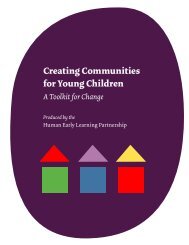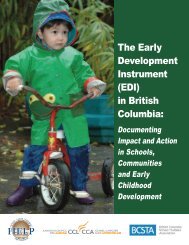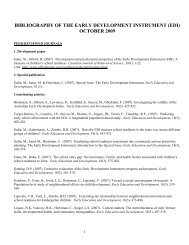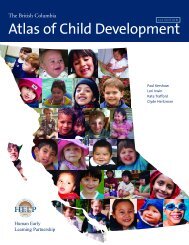Total Environment Assessment Model for Early Child Development
Total Environment Assessment Model for Early Child Development
Total Environment Assessment Model for Early Child Development
Create successful ePaper yourself
Turn your PDF publications into a flip-book with our unique Google optimized e-Paper software.
Spheres of<br />
Influence:<br />
The Individual<br />
environmental exposures (i.e. experiences),<br />
which stimulate the activation of this<br />
in<strong>for</strong>mation, and affect the way in which this<br />
in<strong>for</strong>mation is expressed. This interactive<br />
process is known as biological embedding [11],<br />
though there are also many other analogous<br />
terms used <strong>for</strong> the concept of nature-nurture<br />
interactions, particularly those that occur<br />
during the early years of life. The interest here<br />
is in the interplay—moment to moment, hour<br />
to hour, day to day—between the environments<br />
where children and their families live,<br />
work, and grow up, on the one hand, and<br />
the biological development and responses of<br />
these children, on the other. In this section,<br />
the scientific basis <strong>for</strong> the notion of biological<br />
embedding is explored.<br />
The types of studies discussed here reflect<br />
the current state of the available in<strong>for</strong>mation.<br />
Accordingly, much of what is presented<br />
about this process is derived from animal<br />
studies (See Appendix A), and pertains to the<br />
earliest times of infancy, and to very proximal<br />
environmental influences. In later years, as<br />
functional developmental skills emerge, the<br />
environmental influences that have been<br />
studied broaden, however specificity regarding<br />
the processes through which biological<br />
embedding occurs has often been sacrificed.<br />
For subsequent sections in which the role of<br />
the broader environment is discussed without<br />
direct reference to the biological processes<br />
that are concomitantly induced, the present<br />
section is also intended to serve as a foundation<br />
<strong>for</strong> inferring how macro-environments<br />
might interact with biologic and genetic<br />
processes occurring within young children.<br />
Basics of the Developing Brain<br />
<strong>Environment</strong>al factors—physical, social,<br />
cultural, and economic—are critical to the<br />
healthy development of the human brain.<br />
So significant are experiences and exposures<br />
derived from the environment that science is<br />
unable to discern which if any genetic factors<br />
would be able to properly ‘guide’ even the<br />
most basic neurophysiological development<br />
without the input of the environment.<br />
Not even the development of the core<br />
components of the Central Nervous System<br />
is predestined by genetic constitution, and<br />
requires certain in-utero environmental<br />
characteristics to be present. However, since<br />
these environments are almost universally<br />
available, cns development occurs so uni<strong>for</strong>mly<br />
amongst children that the influence of<br />
the environment in this regard is not readily<br />
apparent [13]. Further, some effects of biological<br />
embedding maintain their impact over<br />
multiple generations, which then also renders<br />
the misleading appearance of a solely genetically<br />
driven phenomenon [13].<br />
A telling example comes from sex-specific<br />
differences in development that are often<br />
attributed to genetic differences between<br />
males and females. On average, the brain and<br />
many brain structures are 10% larger in boys<br />
than in girls, though there are some structures<br />
<strong>for</strong> which girls exhibit larger size. This may be<br />
driven in part by differences in sex hormones,<br />
however, there is also evidence that the<br />
physical environment influences observed<br />
brain-size differentials [14].<br />
Science has progressed sufficiently far<br />
that we now understand some of the exact<br />
mechanisms through which human physiology<br />
is altered by the environment. Differences<br />
in biological embedding (which, to reiterate,<br />
are primarily driven by differences in experiences<br />
and exposures rather than in genetic<br />
coding) result in demonstrable systematic<br />
differences in the function of at least three<br />
important physiological control systems:<br />
the Hypothalamic-Pituitary Adrenal (hpa)<br />
Axis (which controls cortisol secretion), the<br />
Sympathetic-Adrenal-Medullary (sam) Axis<br />
(which controls epinephrine and noreepinephrine<br />
secretion), and the Pre-frontal cortex<br />
(which controls executive brain functions).<br />
As well, biological embedding spurs two<br />
simultaneously occurring processes: the production<br />
(in fact, overproduction) of neurons,<br />
neural pathways, and synapses between<br />
neural cells, and the simultaneous elimination<br />
of ‘unnecessary’ cells. These phenomena are<br />
collectively called neural sculpting [15]. Such<br />
fine tuning—the extent and type of production<br />
and elimination of neurons and neural<br />
connections—are also heavily dependent on<br />
the experiences and environmental stimuli to<br />
which children are exposed[13].<br />
The environment, then, plays a central<br />
role in facilitating ‘healthy’ neural sculpting.<br />
20








